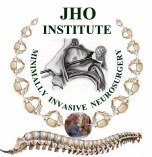Jho Institute for Minimally Invasive Neurosurgery Department of Neuroendoscopy
Spine Diseases
Brain Diseases
Chiari Malformation: Dr. Jho's Chiari Malformation Surgery via small skin incision
A Minimally Invasive Neurosurgery : Dr. Jho's Endoscopic Chiari Decompression for Chiari Malformation
Professor & Chair, Department of Neuroendoscopy
Jho Institute for Minimally Invasive Neurosurgery
Dr. Jho's endoscopic Chiari decompression
Instead of conventional decompression surgery via a large skin incision and extensive tissue dissection, Dr. Jho places a 1.5 cm trocar via a 2-cm skin incision. Under direct endoscopic visualization, suboccipital craniectomy and appropriate cervical laminectomy is carried out followed by dural patch graft with the use of dural closure microclips.

Overview
Chiari malformation is a condition in which the brain tissue of the cerebellar tonsils has herniated into the cervical spinal canal. In the original description, four different types of this congenital malformation were reported. Type I is the mildest form which consists of the cerebellar tonsils being displaced into the cervical spinal canal. This condition can impair cerebrospinal fluid (CSF) circulation and can compress the brainstem or spinal cord. Type II consists of downward displacement of the brainstem into the spinal canal in addition to downward displacement of the cerebellar tonsils. It occurs most commonly with the congenital anomaly of meningomyelocele and spina bifida. Type III is a combined condition of Type II with cervical meningocele. Type IV involves underdevelopment of the cerebellum.
The adult form of Chiari malformation is usually Type I. Because of CSF circulation blockage by Chiari malformation, CSF can accumulate in the spinal cord itself and cause syringomyelia. Hydrocephalus can develop as well. Syringomyelia is a condition in which the spinal cord is distended because of fluid accumulation in the spinal cord itself. When syringomyelia accompanies Chiari malformation, it commonly occurs in the cervical spinal cord. Syringomyelia can cause pain, numbness, difficulty in use of the arms or legs, muscle loss in the hands, and bowel and bladder disorder. When Chiari malformation causes compression at the brainstem and spinal cord, it can cause difficulty in swallowing, eye movement disorder, headaches, vertigo, balance disorder, muscle atrophy of the arms and hands, spasticity of the legs, gait disorder, and bowel and/or bladder disorder.
Classic conventional treatment is surgical decompression that consists of bone removal at the occipital bone and spine, and enlargement of dural covering at the craniospinal juncture with dura graft placement. Syringomyelia usually resolves when adequate Chiari decompression is performed. If syringomyelia does not resolve by Chiari decompression, a shunt catheter has to be placed in order to drain the accumulated fluid in the spinal cord.
Dr. Jho performs Chiari decompression with minimally invasive endoscopic techniques. With endoscopic techniques, the Chiari decompression procedure is performed via a small incision, but achieves adequate decompression as conventional microscopic decompression does. The minimally invasive endoscopic decompression enhances a patient's quick recovery with less postoperative pain and a shorter hospital stay than in conventional procedures.
Practice Manager: Robin A. Coret
Tel : (412) 359-6110
Fax : (412) 359-8339
Address : JHO Institute for Minimally Invasive Neurosurgery
Department of Neuroendoscopy
Sixth Floor, South Tower
Allegheny General Hospital
320 East North Avenue
Pittsburgh, PA 15212-4772
Copyright 2002-2032


